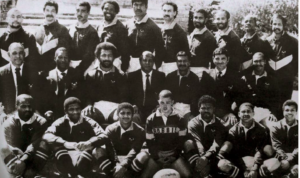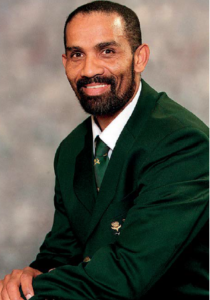In the eighth instalment of a series on black rugby legends, GARY BOSHOFF looks back at the career of former Saru fullback Irven October.
EARLY LIFE
Irven October is one of the best rugby players to have come out of the Helderberg Basin.
He was born in 1959, in what was commonly known as Halfway (Halfweg), the area between the towns of Somerset West and Strand. He was the fifth of six children of Frank and Diana October who, as artisan carpenter and seamstress respectively, still managed to provide for their family.
Frank played scrumhalf for the local St Georges Rugby Football Club, while his brother, Johnny, was flyhalf. So, young Irven’s exposure to the game started with his family.
The Helderberg Basin was home to a healthy rugby culture and the almost daily exposure to and participation in the game led to October’s undying affinity for the sport. Frank was the perfect role model and gained selection to the Somerset and Districts Rugby Union. He also represented the union at the 1960 interprovincial Rhodes Cup tournament.
Irven attended St Georges, Rusthof and CH Rhode primary schools (due to the rezoning of the Halfway area into an industrial zone) before enrolling at Gordon High School in 1973. He participated in rugby and athletics and fondly recalls how his coaches referred to him as a ‘natural athlete’. He played in the front row, at flank and scrumhalf.
In 1973, with the establishment of the St Georges junior rugby club, rugby became October’s No 1 recreational activity. He and his cousins decided to play for the club and not the school. Under the guidance of Wilfred Baard, his uncle, the club thrived and became the biggest junior rugby club in the Helderberg Basin.
The access to good coaching, and the fact that they could play the game regularly and competitively from a young age, helped October and his peers to develop into skilful and enthusiastic rugby players.
When he had finished his high school education, he joined his father as an artisan assistant and attended trade school to become a qualified carpenter.
RUGBY CAREER
October had his first taste of senior rugby in 1977 when, as an 18-year-old, he was selected for the St Georges 1st XV at flyhalf. His brother Ralph was at scrumhalf. His natural ability and skills catapulted him into the Somerset Board side the following year, when he made his SA Cup debut against Boland. He was fortunate enough to be partnered with one of his idols, Mikey Fisher, a Saru and Somerset Board veteran.
‘Mikey had the ability to control things from the base of the scrum and right from the outset had a calming and reassuring effect on me. I can still remember it as if it was yesterday,’ says October with a smile.
The following year, he was moved to fullback, due to the loss of the famous Clive de Waal to Western Province.
‘I did not like the idea at first, but loved the extra space and time so much that it became my preferred position. It was careerchanging,’ he says.
October had the ability to launch counterattacks and join the backline with exquisitely timed acceleration.
During his career, which spanned 14 years, he played in more than 185 SA Cup matches for the Somerset Board and Tygerberg Rugby Union. He also twice represented the President XV (a regional team selected to play against the Saru team). He was selected for the Saru national team for the first time in 1986 and again in 1987, 1988 and 1991 – an unprecedented reign of six years as the best fullback in non-racial rugby.
October has special memories of the Saru team’s visit to Namibia in 1987. They thrashed the Namibians in their backyard and he set a Saru record of 30 points after converting all the tries, kicking two penalties and scoring a try.
In 1988, he moved to the UWC Rugby Football Club in Bellville and became eligible to play for the Tygerberg Rugby Union. At this point, he was playing the best rugby of his career and was a member of the Tygerberg team that played in two SA Cup finals.

October was also a member of the team that won the last SA Cup competition before unity, in 1991.
He continued to distinguish himself and was selected for the unified Western Province Rugby Union’s Currie Cup side, earning five caps before retiring from provincial rugby.
October continued to play club rugby for UWC and later also for Helderberg Rugby Club in the WP Premier League.
In 1994, he was asked to lead a Western Cape sevens team (sponsored by Ithuba Lottery), to a sevens tournament at Twickenham in London. The team, coached by the late Millin Petersen, made waves with their attacking flair, but fell short of the title when they lost against Leicester. October, who turned 34 that year, rates the final in front of 52 000 people as one of the highlights of his illustrious career.
His biggest highlight came in 2001 when he was coach of UWC. The team ran out of replacements and he had to take the field.
During the game, the 40-year-old broke through the defence and sent his only son, Franklin, who was playing centre, over for a try.
October is also extremely proud to have been part of the opening ceremony of the 1995 World Cup at Newlands, where he shared the platform with then president Nelson Mandela.
The French great Serge Blanco was his international rugby idol and he modelled his game on the fullback. Locally, Gabriel Noble, a brilliant Saru centre, was the best he played with.
LIFE AFTER RUGBY
October became a coach and administrator of note. He coached the UWC, Belhar, St Georges and Helderberg rugby clubs in the WP Premier League and was part of Nick Mallett’s Springbok technical team from 1997-2000.

Springbok technical team
He has been happily married to Ursula for 36 years and they have three children, Carmen, Franklin and Shannon.
October managed to successfully negotiate the treacherous waters of pre- and postunity rugby politics and the diverse impact it continues to have on the game. He has worked for SA Rugby for 17 years and is now its asset care manager.
October remains loyal to rugby and still has ambitions of coaching at the highest level. Hopefully he will succeed, because he has got what it takes and he is intimately aware of what the game needs.
– This article first appeared in the November 2017 issue of SA Rugby magazine





